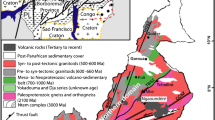Abstract
The magmatic record of rift-related processes operative along incipient continental margins often is obliterated or modified by subsequent compressional tectonic events. Nevertheless, analysis of such igneous rocks is important in determining the nature of sources and melt-generating processes involved in large-scale cratonic rifting. Magmatic activity associated with regional extension produced more than 20 granitoid plutons within the Laurentian Appalachians of Virginia and North Carolina. The plutons and associated volcanic rocks constitute a supersuite that spans an age range of at least 760-700 Ma and defines a period of magmatism that preceded development of oceanic crust by about 130 m.y. Plutons constituting the supersuite, which includes granitoids of the Crossnore Complex and Robertson River Igneous Suite, among others, are variable in size, typically elongate, and range from monzogranite to alkali feldspar syenite. Most plutons record a sequence of multiple intrusions that, in the large Robertson River batholith, spanned at least 35 m.y. The plutonic and associated volcanic rocks of the supersuite display many petrologic characteristics of A-type granitoids including (1) metaluminous to (relatively rare) mildly peralkaline bulk compositions, (2) high (relative to well-documented I-, S-, and M-types) Zr, Nb, Ga, Y, REF (not Eu), Fe/Mg, and Ga/Al, and (3) common occurrence of hypersolvus feldspar assemblages, Fe-rich ferromagnesian silicates, fluorite, and REF-bearing accessory phases including allanite. Intrapluton compositional variation is locally significant and reflects both source- and fractionation- (dominantly feldspar and/or accessory minerals) related mechanisms, locally modified by Fluid-driven, late- and post-magmatic processes. Trace element data from the most thoroughly studied plutons indicate that the peralkaline rocks are not petrologic derivatives of the more abundant metaluminous types. Moreover, comparison with other well documented suites suggests that the peralkaline rocks exhibit source-related characteristics similar to ocean-island basalts whereas metaluminous types display characteristics similar to bulk continental crust. Results of experimental investigations by other workers in which A-type metaluminous granite liquids were produced through melting of charnockitic rocks representative of the Grenville-age basement of the Virginia Blue Ridge support derivation of the metaluminous magmas from sources of similar composition. Sm-Nd isotopic data for the Robertson River Igneous Suite have epsilon-Nd values (calculated for crystallization ages of 730 Ma as indicated by U-Pb isotopic analyses of zircon) ranging from -0.1 to +2.1 and model ages from 1.1 to 1.3 Ga. These model ages overlap with the age range of basement in the Blue Ridge. Epsilon-Nd values increase with decreasing age within the suite. Older metaluminous units have epsilon-Nd values indicative of interaction with evolved crust (-0.1 to +1.4) but the younger peralkaline units show more positive epsilon-Nd values (+1.8 to +2.1) that suggest either a change in source characteristics or degree of crustal contamination with time. Collectively, these data indicate that abundant metaluminous magmas associated with the earliest stages of Laurentian rifting were produced dominantly through melting of local continental crust and that such melts diversified in composition largely through crystal fractionation. Coeval peralkaline magmas, produced during the waning stages of this period of regional magmatic activity, were generated through melting of more geochemically primitive sources; however, the magmas evolved compositionally through similar mechanisms. The mode of occurrence, type and range of compositions, and inferred petrogenesis of the supersuite are similar to those of anorogenic, encratonic granitoids documented worldwide. The Laurentian Appalachian supersuite represents a significant, long-lived, temporally episodic period of magmatism that ended with encratonic rifting but not development of oceanic crust. As such, the rocks are indicative of processes operative during the earliest, pre-drift stages of Laurentian extension.
Access this chapter
Tax calculation will be finalised at checkout
Purchases are for personal use only
Similar content being viewed by others
Author information
Authors and Affiliations
Editor information
Editors and Affiliations
Rights and permissions
Copyright information
© 1998 Springer Science+Business Media Dordrecht
About this chapter
Cite this chapter
Tollo, R.P., Hutson, F.F. (1998). Petrology and Geochemistry of a Late Proterozoic Anorogenic Supersuite, Laurentian Appalachians, Virginia and North Carolina: Implications for Magma-Generation Associated with Cratonic Extension. In: Hogan, J.P., Gilbert, M.C. (eds) Basement Tectonics 12. Proceedings of the International Conferences on Basement Tectonics, vol 6. Springer, Dordrecht. https://doi.org/10.1007/978-94-011-5098-9_48
Download citation
DOI: https://doi.org/10.1007/978-94-011-5098-9_48
Publisher Name: Springer, Dordrecht
Print ISBN: 978-94-010-6141-4
Online ISBN: 978-94-011-5098-9
eBook Packages: Springer Book Archive




